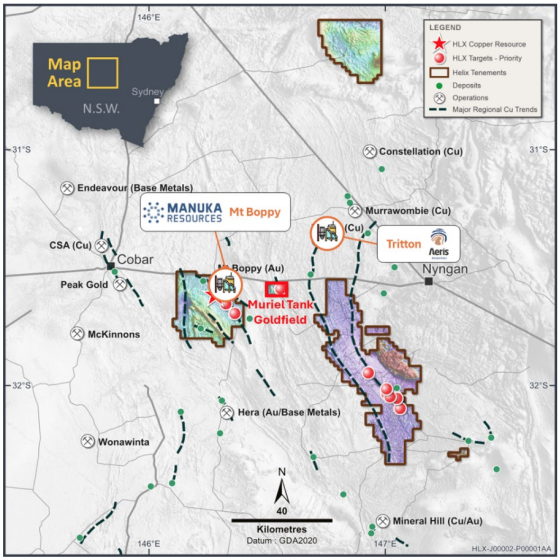Helix Resources Ltd (ASX:HLX) has compiled historical results from the Muriel Tank gold project, 60 kilometres west of Nyngan in central NSW, where the company is undertaking new exploration for gold and copper.
Helix, which owns 100% of the historic Muriel Tank gold mining area, recently completed a major data compilation exercise ahead of planned gold focused exploration.
The area features multiple historic mine shafts that produced high-grade gold ore, estimated at around 15 g/t gold, over an area spanning 5-kilometres by 1.5-kilometres that is 20-kilometres east of Manuka Resources’ Mt Boppy Gold Mine. Mt Boppy has 417,000 ounces of high-grade historical gold production.
High-grade gold is present in both quartz-vein samples and wall rock (sediment) samples, as shown by previous rock chip sample results, including:
- 13.8 g/t and 28 g/t gold from quartz at Butlers
- 10.8 g/t gold from quartz at Woolshed East
- 9 g/t and 5g/t gold from quartz at Russells
- 33.8 g/t gold in wall rock greywacke at Fettlers
- 15.5 g/t gold in wall rock shale at Browns Hope
Additionally, previous shallow RC drilling near historic mine shafts recorded the following significant intercepts:
- 3 metres at 1.47g/t gold from 30 metres
- 4 metres at 1.69g/t gold from 67 metres
- 1 metre at 1.74g/t gold from 34 metres
- 8 metres at 0.75g/t gold from 8 metres
Gold was historically extracted at Muriel Tank from quartz veins and breccias up to 2-metres wide. These mineralised structures occur within several shear zones and, notably, remain open at depth and along strike.
Gold exploration at the right time
Helix’s completion of the Murial Tank data compilation coincides with not only record global gold prices, but the construction of a gold processing plant at Manuka’s Mt Boppy project.
Muriel Tank tenement and proximity to the Mt Boppy Gold Mine and Tritton Copper-Gold Mines
The company sees “excellent opportunity” to make further gold discoveries, which, based on the historical mine grades, could be trucked to a number of regional processing plants.
Past mining and exploration at Muriel Tank predominantly targeted exposed quartz veins, leaving the potential along strike and at depth largely unexplored.
Wall-rock mineralisation and sub-parallel veins have not previously been systematically sampled either, presenting a significant opportunity to assess the full potential of the gold project.
Helix managing director Kylie Prendergast said: “With the historical compilation largely complete, the untested opportunities in the Gold Project are clearly emerging. Historical gold is reported over a sizable 5.5-kilometre by 1-kilometre area and previous drilling was very patchy.
“Our new regional structural model gives us an edge in understanding the controls on the mineralisation and hence, where we might find more, especially under cover.
“International gold prices are high, and Muriel Tank is well located close to current processing infrastructure suitable for gold recovery including the new plant under construction at the Mt Boppy Gold Mine 20 kilometres to the west as well as Aurelia’s Peak Plant and Kingston’s Mineral Hill Plant – though further away.”
Muriel Tank geology and structure location of historical mines
Work planned: new copper-gold discovery potential
Helix has planned new work programs to systematically evaluate the extent of gold mineralisation along strike, in wall rocks and in covered areas between exposed veins and existing workings.
The company has built up a detailed regional-scale structural model which provides valuable, new insight on the controls of this style of gold mineralisation. Work programs will incorporate more rigorous drilling and sampling quality assurance and control (QAQC) procedures to effectively test for coarse gold.
“Helix is focused on advancing several priority targets in its pipeline which we believe have potential to deliver a new copper-gold discovery in the highly endowed Cobar region close to established operations and processing facilities,” said Prendergast.
Read more on Proactive Investors AU
